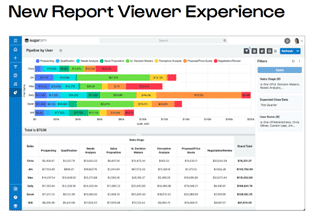The News:
SugarCRM announced in early May the addition of powerful new user experience (UX) improvements via the launch of Sugar Enterprise+, its salesforce automation platform for on-premises customers. The newest version of the Sugar Enterprise platform includes a user interface (UI) redesign, a report viewer refresh, new service capabilities, built-in integrations, console metric tabs and usability upgrades, and administration and business process outsourcing management (BPM) enhancements.

See the complete press release from SugarCRM here.
SugarCRM Enterprise Release Features New User Experience Improvements
Analyst Take:
SugarCRM announced the latest version of its on-premises sales automation platform, Enterprise+, which is now available with many of the latest UX improvements from its cloud-based Sugar Sell premium edition.
Continuous user experience improvements are table stakes for CX software
Sugar Enterprise+ now features UX improvements, such as the availability of guided selling, geo-mapping, mail and calendar integration, automatic data enrichment, and news feeds to empower sales teams to increase efficiency, engage more effectively with buyers and prospects, shorten sales cycles, and ultimately drive revenue growth. A modernized Sugar Enterprise UI has been designed to improve ease of navigation and information access, with new, expanded out-of-the-box reporting and business process automation templates.
From a customer experience perspective, SugarCRM is smartly incorporating the UX improvements that are often considered table stakes in cloud platforms, and making them available to customers that have not or will not migrate sales operations to a cloud-based platform. While cloud-based and hybrid sales and CX platforms have become the darlings of the CX software industry, a significant portion of the market is unlikely to fully embrace a cloud-only environment.
In addition, the base level Sugar Enterprise and Sugar Enterprise+ solutions include UX improvements designed to support the customer journey throughout the full lifecycle, including Sugar’s Service Console, a digital workplace including a powerful dashboard specifically designed for customer service representatives, and new forecasting enhancements provide more comprehensive visibility of overall pipeline and sales opportunities.
Cloud-based deployments are not suitable for all organizations
Indeed, some organizations remain reluctant to outsource data security to a cloud provider, or do not want to incur the higher long-term costs of using a fully cloud-based solution. Others may simply not be able to fully embrace a cloud environment due to the use of legacy, server-based apps or the presence of data-handling regulations that may impact where information may be used, stored, or transferred.
By incorporating some of the tools and features from its cloud-based products, SugarCRM has realized that UX improvements should not be made available only to cloud-based customers. Likely, organizations that need to maintain an on-premises solution increasingly will seek out solutions that can provide a cloud-like user experience, while also allowing seamless connections to other third-party applications via integrations. A key example is SugarCRM’s integrations with the cloud-based Dropbox and DocuSign applications.
On-premises or hybrid on-premises/cloud deployments are likely to continue to be preferred by organizations with specific data and operational considerations. In this hyper-competitive CX ecosystem, vendors that can continue to provide UX improvements to a wide range of customers, particularly those who may be unwilling or unable to quickly leap to a full cloud deployment, are well positioned for success.
Author Information
Keith has over 25 years of experience in research, marketing, and consulting-based fields.
He has authored in-depth reports and market forecast studies covering artificial intelligence, biometrics, data analytics, robotics, high performance computing, and quantum computing, with a specific focus on the use of these technologies within large enterprise organizations and SMBs. He has also established strong working relationships with the international technology vendor community and is a frequent speaker at industry conferences and events.
In his career as a financial and technology journalist he has written for national and trade publications, including BusinessWeek, CNBC.com, Investment Dealers’ Digest, The Red Herring, The Communications of the ACM, and Mobile Computing & Communications, among others.
He is a member of the Association of Independent Information Professionals (AIIP).
Keith holds dual Bachelor of Arts degrees in Magazine Journalism and Sociology from Syracuse University.







